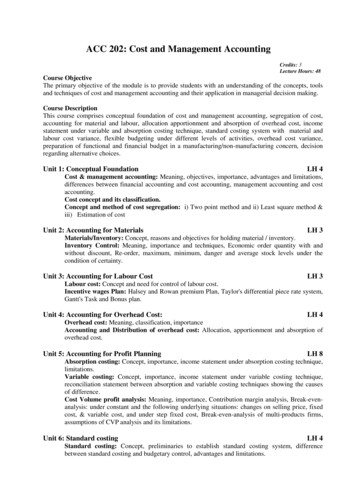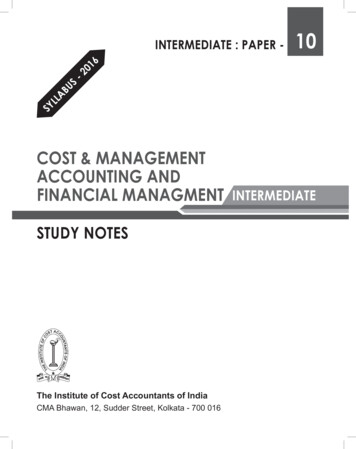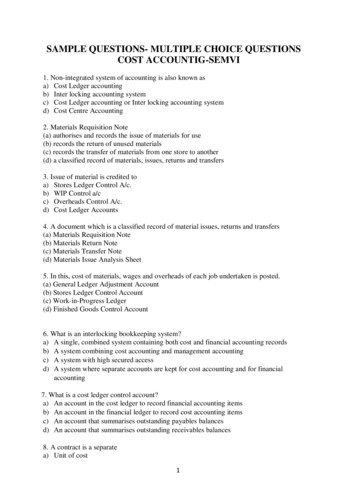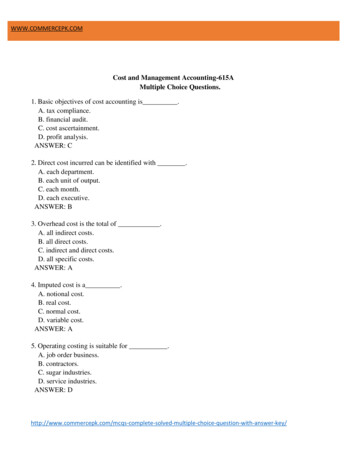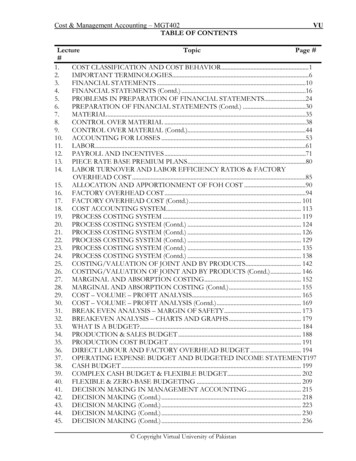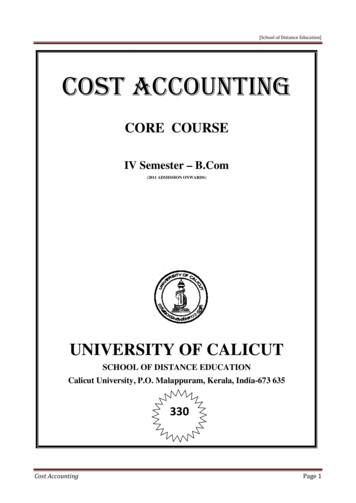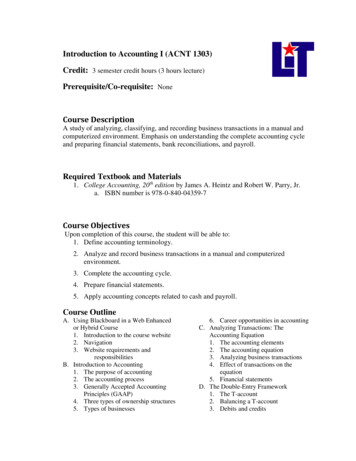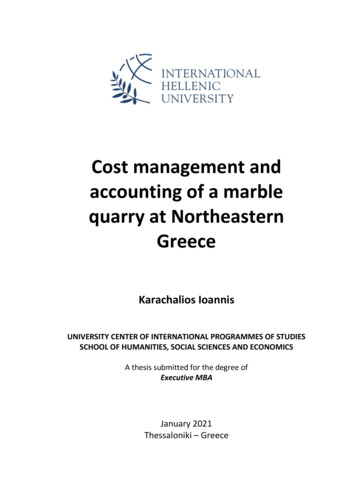
Transcription
Cost management andaccounting of a marblequarry at NortheasternGreeceKarachalios IoannisUNIVERSITY CENTER OF INTERNATIONAL PROGRAMMES OF STUDIESSCHOOL OF HUMANITIES, SOCIAL SCIENCES AND ECONOMICSA thesis submitted for the degree ofExecutive MBAJanuary 2021Thessaloniki – Greece
Student Name:Ioannis KarachaliosSID:Supervisor:1101190005Prof. Alexandros SikalidisI hereby declare that the work submitted is mine and that where I have made use ofanother’s work; I have attributed the sources according to the Regulations set in theStudent’s Handbook.January 2021Thessaloniki - Greece
1. AbstractThis dissertation was written as part of the Executive MBA at the International HellenicUniversity.This dissertation deals with the costing and cost management of a marble quarrylocated in northeastern Greece, an area that is the most important quarry center inthe country. Analyzing the marble market and the strong brand name of Greekmarbles we will mention the reasons for the continuing increase in demand for Greekmarbles abroad. Then, we will refer to cost management and the ABC costing methodthat we will use to calculate the cost of a specific marble quarry.Next, we will analyze in detail the production process of the quarry and thetechnology, the production inputs; the description of procurement program and thecost of spare parts and consumables. Then, we will describe the productionorganization; the departments, its responsibilities and how they interact betweenthem. Afterwards, we will emphasize at staffing and manpower and their importancefor the operation of a business and we will calculate the labor cost of the quarry.Finally, we calculate the operating cost and the total production cost by using all theavailable data and we propose solutions to reduce the cost of this marble quarry. Atthe end of our analysis, it is perceived that the activities with the highest cost are theloading and transporting of the sterile material and the transport-weighing andplacement of the marble blocks and we examine ways to reduce them such as buying adumper truck with bigger transport capacity.I would like also to thank Prof. Alexandros Sikalidis for his important help and guidancein the preparation of this dissertation. Ηis contribution to the completion of the workis remarkable.Keywords: cost management, marble quarry, ABC method, operation cost, productioncostKarachalios Ioannis12/1/2021
2. Contents1. ABSTRACT . III2. CONTENTS .V1. INTRODUCTION . 12. COST MANAGEMENT & ABC METHOD . 53. PRODUCTION PROCESS & TECHNOLOGY . 84. PRODUCTION INPUTS . 124.1 DESCRIPTION OF PROCUREMENT PROGRAM .145. ORGANIZATION UNIT 1: PRODUCTION ORGANIZATION. 175.1 MINING & PRODUCTION DEPARTMENT .175.2 REPAIRS AND MAINTENANCE DEPARTMENT .185.3 QUALITY CONTROL DEPARTMENT .185.4 PROCUREMENT DEPARTMENT .195.5 SALES DEPARTMENT .196. ORGANIZATION UNIT 2: STAFFING AND MANPOWER . 206.1 ESTIMATION OF LABOR COSTS .237. OPERATING COST AND TOTAL PRODUCTION COST . 257.1 COST OF CONSUMABLES.267.2 FUEL- ENERGY COST .267.3 COST OF LUBRICANTS .277.4 COST OF CUTTING MATERIALS .307.5 COST OF TIRES .317.6 COST OF EXPLOSIVES .317.7 COST OF OTHER CONSUMABLES .317.8 COST OF SPARE PARTS .327.8 GENERAL ADMINISTRATION EXPENSES .377.9 COSTS OF SALES AND DISTRIBUTION.37-v-
7.10 TOTAL COST .377.11 GROSS PROFIT MARGIN OF THE QUARRY .388. CONCLUSIONS . 399. BIBLIOGRAPHY . 4110. APPENDIX. 1-vi-
1. IntroductionIn contrast to the contraction of the internal market of construction materials, which shows adecline from 2008 onwards, the marble sector all these years continues its upward trend withthe main element being its export orientation up to 75-80% of the total production of theproduced marble products. In the last decade, due to the recession in the Greek economy,the industry was called to redefine its role, to show extroversion and to change its strategy,mainly addressing the global market. Thus, it continued its growth course in response to thegrowing demand of foreign markets (Fig.1, Appendix).The value of exports in the whole sector of marble and natural stone products, according tothe data of the Hellenic Statistical Authority (EL.STAT & Eurostat) and the processing by theMinistry of Environment and Energy (MEE) in 2018 amounted to 580 million euros and thequantity and exports of marble products amounted to more than 1.1 million tons (Fig.2 & 3,Appendix). As a result, Greece holds the 4th place in the world ranking of marble exports, the3rd place in the world in the ranking of raw marble exports (marble blocks) as Greek marbleexports have almost tripled in the last 10 years (Fig.4, Appendix). The Greek marble industry,demonstrating operational readiness and quick reflexes, adopted a purely extrovertedstrategy which, within a decade and despite the intense competition, emerged as one of thelargest exporting forces in the world.New jobs have been created and the demand for skilled staff has increased. The marblesector leaves a strong imprint on the Greek economy, as the supply of the marble productionsector to it reaches 1.27 billion euros and for every 1 euro of marble product the multiplierbenefit is 2.19 euros. The sector employs about 7,000 people, while the total contribution toemployment (indirectly) reaches 20,000 employees (ICAP study for the Marble BusinessAssociation of Eastern Macedonia & Thrace).65% of raw marble exports go to the Chinese market (ICAP study), which is also the largestimporter of raw marble in the world. The huge market of China is a major conquest for Greekmarble and despite the slowdown in the growth of China's economy from the frantic pace of-1-
previous years; it is a guarantee for the future availability of Greek marble products.Unfortunately, this absorption also has negative sides, since especially for China it concernsalmost exclusively raw volumes of marble, as a result of which the added value is limited butwe also have losses in public revenues due to different tariff policy depending on the degreeof processing of the exported product.Apart from China, important markets that absorb Greek marble are: the USA, the United ArabEmirates, Singapore, Qatar, Italy and Turkey. Especially, the USA is the No. 1 importer ofprocessed marble from Greece and therefore a strategic partner of the Greek marble industryas 15% of Greek exports of processed marble are directed there. They are also the largestimporter of processed marble in the world. Greece holds the 6th place as marble supplier atUSA, following global giants such as Italy, China and Turkey (Hellenic Statistical Authority).All the above prove that Greek marble has strengthened its brand name in internationalmarkets and has become quite attractive. It is also important to improve the competitivenessof the Greek companies with structural changes in the business model, the organization ofwork, quality assurance of products produced and finally the evolution from the simpleprocessing of the sale of standard marble products to the provision of integrated solutions.All the above resulted in companies operating in the marble industry investing over 100million euros only in 2018 to modernize their mechanical equipment, develop new depositsand increase productivity due to the growing demand for Greek marble . A part of thisamount of money was also spent on the acquisition of small and medium-sized companies bylarger ones.In this project we will deal with the costing of a marble quarry located in northeasternGreece, in the area that is considered the largest quarry center in Greece and its marbles havethe highest demand. We will analyze the entire production process and its stages as well asthe activities of each stage and we will propose solutions to improve cost management bymanagers. We will identify the processes that have the most significant impact on the cost ofthe production process and we will propose solutions to reduce them. Executives of marblecompanies will understand that transportation costs are the highest in the production processand should consider one of the proposed solutions. Also, they will realize that the cost of-2-
transport and distribution is high but unfortunately cannot be reduced due to the distance ofthe quarries from the points of transshipment.-3-
2. Cost management & ABC methodToday, the 80% of total Greek primary marble production is located in the region ofNortheastern Greece, where the majority of marble companies are operated. Thenumber of companies operating around the marble has increased and has exceeded150 in this area. From the 5 active quarry centers of the area where more than 135quarries are active (200 licenses) more than 90% (in quantity and value) of the totalmarble is exported (Ministry of Environment & Energy). As a result, it is easy tounderstand the reason we chose to do our research in the quarries of this area.Given the situation prevailing in the marble industry in Greece, it is easy to understandhow vital is for the managers of these companies the cost management and accountingin every decision that they take. A decision can influence the success or otherwise ofthe organization concerned. In particular, management can use the information itcollects from the costing system to make a decision about the price it will set for aproduct. The management gathers the necessary information about the cost ofproduction from the costing system they use and then according to this informationthey can proceed to the price-setting process. Particular interest of cost in pricingprocess is represented by the cost of production and its components. Knowing the costof the individual steps of the production line, managers can check it easily so as to bealways less than the selling price of the product and find ways to reduce it further toincrease the company's profit margin. Cost-based pricing is intended to cover the costsof the business if the price is determined above the cost and a profit margin after thecompany has managed to cover its costs. Generally, cost is not the only factor affectingprice setting, but the role of cost in pricing is crucial as it sets the threshold for pricesetting, strategies and policies.The costing method we will use in this project is the Activity- Based Costing (ABC)Method. Activity-Based Costing (ABC) dates back to 1988 when Cooper and Kaplan tooka different approach to calculating cost. Until then, "traditional" systems were thepredominant ones, such as job order costing, process costing, full costing, direct costing-5-
and standard costing (Kechras, 2009). According to Cokins (1999), the 1980s were theyear in which companies began to realize the inaccuracies arising from "traditional"systems. The latter provided more basis for the costing of direct labor and directmaterials, which were necessary for the production process, and not the otheroverheads which were characterized as an incalculable factor. The emphasis on directlabor was what really prevailed, with the distribution of overheads being done, but in anarbitrary way. In other words, the overhead was allocated in proportion to the unitsthat the companies produced and the sales of the products. This system made"traditional" costing methods relatively unreliable because many of the resultingoverheads corresponded to external activities unrelated to the main "trunk" ofproduction. Thus, the phenomenon of either over-costing or under-costing of productswas common.Ning (2005) in his historical review on the issue of costing, states that the need to shiftfrom "traditional" systems to a system where it would give emphasis on the distributionof overhead costs, arose due to changes in production technologies, control methodsand more generally in forms of competition and the market. Over the years and withthe indirect costs (overheads) in many cases exceeding 60% of the total cost, the needarose for a costing system that would respond to the unreliability of "traditional"methods (Kechras, 2009). This was the A.B.C. The information it would provide was forthe direct purpose of accurately calculating the cost of support activities and as anindirect aimed at the general support of a company's strategic decisions. To this mustbe added the fact that companies have now produced a large number of differentiatedproducts and as Cooper (1988) pointed out this diversity, volume, size and complexityare the factors that lead to the unreliability of "traditional" methods and the need for anew approach.Additionally, O’Guin (1991) states that Activity Based Costing system essentiallyseparates and divides the cost into two groups, the one created by the product and theone created by the customer. The first grouping includes costs directly related to theproduct, such as construction, design, production planning, storage, quality control,supplies, etc. The second group includes costs related to the customer. These are thecosts of delivery, service, support, distribution, sales, advertising, marketing, research-6-
and development, etc. By using this method, we observe that the concept of cost iscorrelated with the customer.Activity costing can therefore be described as a method of allocating indirect costs. TheA.B.C. takes into account not only overheads related to the production process but alsothe costs associated with other functions which may not be directly related toproduction but which play an important role in a business (marketing, logistics, etc.)(Turney, 1996). Therefore activities (which can range from a simple issuance ofdocuments and payment of bills of exchange to the maintenance of equipment and thepalletizing of products) and their costs, play the most important role in this method. Byassigning costs to the activities of a company, the management is in the advantageousposition of controlling the causes that cause it and the degree to which this happens. Sothere can be a targeted approach on the part of the company to reduce costs, as long asit knows, through the ABC method, its sources of challenge.The basic concepts that characterize the ABC method are: resources, cost objects, costdrivers, activities, resource drivers & activities, performance indicators and value chain.The validity of the information, provided by the adoption of the A.B.C. system, is a toolfor the companies to take the right decision, for the critical evaluation of the productportfolio and in general for the planning of operations and activities.-7-
3. Production process & technologyThe production process includes all the processes that take place in a production line aswell as the technology that is used in order to produce one or more products. Duringthe production process, energy is consumed either in the form of electricity or by thecombustion of conventional fuels. In this chapter we will report and analyze the entireproduction process that takes place in a marble quarry as well as the technologicalmeans used to produce marketable marble blocks. The Picture 1 presents theproduction process of the quarry.Picture 1: Production process of the quarry-8-
Cleaning of the area of the deposit to be exploited: At the beginning of the production process it isnecessary to clean the area to be exploited both for the safety of the workers and the machinesthat will work there and for the better evaluation of the quality of the marble deposit. This is doneby using small wheel loaders operated by qualified personnel.After assessing the area to be exploited, we decide whether the quality of the deposit is good forthe production of marketable marble blocks or not and this area will be blown up using explosivesfor the faster progress of the exploitationDrilling horizontal holes for marble blocks production or to blow up the deposit: In this phase ofthe production process, the deposit is divided into equal-sized rectangular parallelepipeds 12mlong, 1.7m wide and 6.5m high in the case of marble blocks production or it is drilled (only 2horizontal drills) in the case that the deposit is not marketable and it will be exploded. Thehorizontal holes are made using specialized drilling machines which are handled by licensedoperators.Drilling vertical holes for marble blocks production or to blow up: In both cases the deposit will bedrilled vertically with a specific type of drilling machine. In case the deposit in the specific area willbe blown up, the holes will be more as some of them will be filled with explosives. This machine isoperated by a licensed operatorExtraction by using an electric chainsaw: In cases where there are no 3 free surfaces in thedeposit, the use of horizontal drilling machines becomes impossible. In this case we use an electricchainsaw for horizontal cutting which is used after the drilling of vertical holes.Cutting the deposit using wire-saw machine and water: During that process, a worker uses wiresaw machine in order to cut the marble deposit first horizontally and after vertically. A diamondwire is used as a cutting tool which is passed through the holes drilled by the drilling machine inthe previous step. Water is used during the cutting and the wire-saw machine is operated withelectrical power.Detachment of a bench from the deposit: After the end of the cutting process, the bench isdetached from the parent rock. First, we transport fine-grained soil by dumpers which we place infront of the bench that we will extract to avoid possible breakages of the bench when it falls. Thismaterial is uniformly formed using a big wheel loader or crawler excavator. Next, two workers-9-
remove the bench from the deposit using a water pump and an expansion bag (water pillow).Finally, a crawler excavator pushes the bench so that it falls on the soil that we had formed in theprevious step.Explosive charge and explosion: As it mentioned before in case the deposit cannot producemarketable marble blocks due to poor quality at its specific area then it is blown up usingexplosives. The vertical holes are filled with explosives (except those used for the diamond wire tocut the deposit) and it is blown up. Charging and blasting is done by a licensed employee for thistype of work.Bench marking and secondary cutting: At this stage of the extraction, the bench is carved byexperienced personnel in order to cut it secondary and to produce as ‘’healthy’’ and marketablemarble as possible. It is obvious that at a marble deposit there are problems (fractures, cracks)which cannot be included in the marketable final product. The secondary cutting is done using amachine with a hydraulic drilling unit by a licensed operator while bolts are used at the end of thecutting to “open” the bench.Rectangulation of the marble block: After the bench is opened, a wheel loader transports thegood pieces of the bench one by one to be re-examined by the same experienced personnel whore-engraved these pieces and then cut them with a wire-machine in order to have the final marbleblock (product).Loading and transportation of sterile material: At this stage of the production process the nonmarketable material from the blasts, from the bench marking and the rectangulation of themarble blocks are loaded with wheel loaders in dumpers which transport them in the landfills ofsterile material of the quarry. The loaders and dumpers have diesel engines and the workers arelicensed operators.Transportation of marble blocks: After the rectangulation of the marble blocks, they aretransported by wheel loaders for quality control.Quality control: The quality control of the marble blocks is done by specialized personnel whichclassifies the blocks in qualities while rejecting the non-marketable blocks.-10-
Transportation- weighing- placement: After the quality control the blocks are loaded in dumperswith loaders and after being weighed, they are placed in the customers' areas.-11-
4. Production InputsIn economics, factors of production, resources, or inputs are describing the general inputsused to produce finished goods and services and to make profit. The utilized amounts of thevarious inputs determine the quantity of output according to the relationship called theproduction function. There are four basic resources or factors of production: land, labor,capital and entrepreneurship. The factors are also frequently labeled "producer goods orservices" to distinguish them from the goods or services purchased by consumers, which arefrequently labeled "consumer goods" (Samuelson et al, 2004).There are two types of factors: primary and secondary. The previously mentioned primaryfactors are land, labor, capital and entrepreneurship. Materials and energy are consideredsecondary factors in classical economics because they are obtained from land, labor, capitaland entrepreneurship. The primary factors facilitate production but neither becomes part ofthe product (as with raw materials) nor becomes significantly transformed by the productionprocess (as with fuel used to power machinery). Land includes not only the site of productionbut also natural resources above or below the soil. Recent usage has distinguished humancapital (the stock of knowledge in the labor force) from labor (Samuelson et al, 2004).Entrepreneurship is also considered a factor of production (O’ Sullivan, 2003). Sometimes theoverall state of technology is described as a factor of production (Perkin, 1999). The numberand definition of factors vary, depending on the theoretical purpose and the empiricalemphasis (Friedman, 2007).Land as a factor: Despite the fact that mining has a small share of a country’s total land use,conflict can arise at the local level where mining is perceived as competing with agricultureand livestock grazing or other land uses (Popovic, 2015). It is obvious that in the miningindustry the most important factor of production is the land. A company can operate only inlicensed quarries’ areas that have been granted by the state for a certain time period whilepaying the corresponding rents to the state (7% of sales turnover). In the case of the quarrythat we will analyze in this project, the company has leased the specific quarry area for thenext 40 years with the right of renewal based on Greek quarry legislation. Also, the reserves-12-
of the deposit have been estimated after sampling wells and having collected and analyzedthe production of marketable material in the last decade. All this analysis led us to estimatethe reserves of this deposit at 2 million tons, a large amount that helps entrepreneurship andinvestments.Labor as a factor: Labor refers to the effort expended by an individual to bring a product orservice to the market. Again, it can take on various forms. In our case, labor starts from theproduction workers, operators, technicians and foremen that are paid for their time andeffort in wages that depend on their skill and training and also includes the management ofthe quarry, the sellers of the sales department as well as the central management of thecompany that tries to introduce the products of the company to the market and to signcontracts with customers to increase company’s profits. As far as the quarry staff isconcerned, this is characterized by experience and specialization as the company has beenactive in this quarry for over 25 years.Capital as a factor: When economists refer to capital, they are referring to the assets–physicaltools, plants, and equipment–that allow for increased work productivity. Capital is unlike landor labor in that it is artificial; it must be created by human hands and designed for humanpurposes. This means time must be invested before capital can become economically useful.By increasing productivity through improved capital equipment, more goods can be producedand the standard of living can rise. Capital goods are also sometimes referred to as the meansof production because these physical and non-financial inputs create objects that caneventually be bestowed with economic value.In the quarry that we will analyze, the owner company invests in new mechanical andelectrical equipment (as will be seen from the depreciation) which consists of wheel big andsmall loaders, excavators, trucks, new generation wire saw machines, chainsaws, drillingmachines, air-compressors, hydraulic drilling units, cars 4X4 and buses for the staff transportetc. The operating company uses equity for these investments and does not need to borrowcapital.Entrepreneurship as a factor: Entrepreneurship is the undertaking of new business .Someeconomistsidentifyentrepreneurship as a factor of production because it can increase the productive efficiency-13-
of a firm. Even though entrepreneurship is not land, labor or capital, most placeentrepreneurs in the same critical category as more consistently identified factors ofproduction. In case we will analyze the specific marble quarry, it was acquired by the currentowner company but through pioneering ideas it managed to export it to many countries asuntil then it was known only in the domestic market. It is also worth noting the company'schoice to acquire the specific quarry area (high reserves of the deposit as mentioned above)and not some other neighboring quarry.4.1 Description of procurement programThe company that operates at the specific marble quarry has in its organization chart aprocurement department staffed with the appropriate personnel. This department isresponsible for recording the needs of the quarries by their managers (mining department,maintenance and repairs department) as well as the needs of the other departments locatedat the company headquarters, to request offers by doing market research from suppliers andto complete the orders. We could mention that it was mainly responsible for the purchase ofconsumables and spare parts.Certainly there are some stable suppliers with whom long-term agreements have been signedin order to serve the needs of the company faster and at a certain period of time the marketis researched for the prices of specific materials. In the case that the cost of an order is veryhigh, an offer is requested from at least 3 suppliers and the completion of the order is donewith the written consent of the general manager of the company. There is an ordermonitoring system which indicates the stage at which the order is located which is updateddaily. Through this system, when the order is completed, its cost is transferred to therespective cost center so that we can manage it and to take the right decisions.In each quarry there is an employee who works at the repair department who has theresponsibility to check the orders that have been completed, to arrange them safely in thewarehouse of the quarry and to charge them to the machines during their consumption. Itmust also check and update the logistic system whenever the quantity of a consumable itemhas been reduced because if a new quantity is not ordered there will be a shortage in thefuture. Knowing the rate at which each type is consumed can predict when there will be ashortage. The cost of supplies is estimated at about 1 million per year.-14-
This cost is broken down into consumable cost and the cost of spare parts. The cost ofconsumables is the necessary expenses borne by the production process and consists fromfuel cost, the cost of explosives, the cost of cutting material, the cost of lubricants, the cost oftires and cost of other consum
This dissertation was written as part of the Executive MBA at the International Hellenic University. This dissertation deals with the costing and cost management of a marble quarry located in northeastern Greece, an area that is the most important quarry center in the country.


